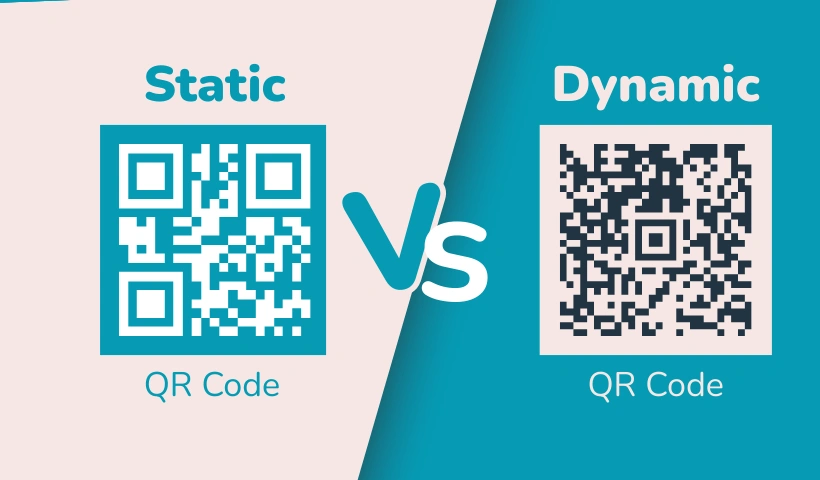QR codes have evolved from a niche technology to a mainstream tool for businesses and consumers alike. Once seen primarily in logistics, they are now widely used in retail, hospitality, healthcare, and marketing campaigns around the world. With just a quick scan, customers can access information, claim offers, or complete transactions, making QR codes an essential part of the modern customer journey.
But not all QR codes are the same. Businesses exploring their use will quickly come across two main types: static and dynamic QR codes. While they look identical on the surface, their functions, flexibility, and applications differ significantly. Choosing the right type is key to achieving the best results.
What Are Static QR Codes?
Static QR codes are generated with fixed data embedded directly in the code itself. Once created, the content cannot be changed. For instance, if a static QR code is set to open a specific URL, it will always lead to that URL, even if the link is no longer relevant or active.
Because of their simplicity, static QR codes are ideal for sharing permanent information. Common uses include linking to instruction manuals, providing Wi-Fi credentials, or directing to a business’s contact details. They are quick and inexpensive to produce, and they do not require a subscription to a management platform.
However, static QR codes have limitations. They cannot be edited once deployed, which means any change—such as updating a campaign landing page or correcting a mistake—requires creating and reprinting a new code. This can become costly and inefficient if used in dynamic marketing environments where content changes frequently.
What Are Dynamic QR Codes?
Dynamic QR codes work differently. Instead of embedding the destination data directly in the code, they contain a short redirect link that can be updated at any time. This means the QR code itself remains the same, but the underlying content can change as needed.
For example, a restaurant might place a dynamic QR code on its tables to display its menu. Over time, as dishes change, the restaurant can simply update the digital menu linked to the code without reprinting signage. Similarly, retailers can use one QR code across multiple campaigns, updating it from a seasonal sale page to a new product launch.
Another major advantage of dynamic QR codes is tracking and analytics. Businesses can gather valuable insights such as how many times the code was scanned, at what location, on what device, and at what time of day. These metrics allow for real-time optimisation of campaigns and provide a clearer understanding of customer engagement.
When to Use Static QR Codes
Static QR codes are well-suited for situations where the information is timeless and unlikely to change. For example:
- Business cards with contact details
- Permanent Wi-Fi network credentials in hotels or cafés
- User manuals and product instructions
- Links to company websites or social profiles
They are reliable, simple, and cost-effective. For organisations with limited budgets or straightforward needs, static QR codes can be an excellent starting point.
When to Use Dynamic QR Codes
Dynamic QR codes excel in scenarios where flexibility, personalisation, and data tracking are valuable. Some practical applications include:
- Marketing campaigns – updating links for seasonal promotions without reprinting codes.
- Restaurants and hospitality – linking to menus or offers that change regularly.
- Retail environments – connecting customers to product pages, AR experiences, or loyalty programmes.
- Event management – providing schedules, maps, or ticketing that can be updated in real time.
- Data-driven campaigns – tracking engagement to inform future strategies.
For businesses looking to maximise ROI and maintain agility, dynamic QR codes are usually the smarter choice.
Static vs Dynamic: Which Should You Choose?
The decision comes down to your objectives. If your goal is to share simple, permanent information without needing updates or analytics, static QR codes are sufficient. But for businesses that value adaptability, data, and efficiency, dynamic QR codes deliver far greater benefits.
It’s also worth noting that the two types can complement one another. Many businesses use static codes for evergreen content while deploying dynamic codes for campaigns that require measurement and flexibility. A balanced approach ensures cost-effectiveness while still allowing for innovation and responsiveness.
Final Thoughts
While static and dynamic QR codes may look identical, their capabilities set them apart. Static codes are straightforward, reliable, and ideal for fixed information, whereas dynamic codes provide flexibility, real-time analytics, and long-term campaign value.
For organisations ready to take advantage of the full potential of dynamic QR codes, Brevix offers an intuitive platform to create, customise, and track QR codes effectively—helping you transform simple scans into actionable insights and stronger customer connections.


